Understanding Native American Culture for Healthcare Professionals
VerifiedAdded on 2023/04/21
|14
|3625
|417
Report
AI Summary
This report provides a cultural analysis of Native Americans, focusing on their religious beliefs, healing practices, family life processes, and communication styles, with implications for healthcare professionals. It emphasizes the importance of cultural competence in nursing, particularly when caring for Native American patients. The report details their reverence for the Great Spirit and nature, their understanding of health as harmony with the spirit world, and their use of traditional healers like medicine men and women. It also discusses the significance of family structures, respect for elders, and specific customs related to death and dying. The report advises nurses to respect patients' decisions to involve cultural healers, accommodate family rituals, and communicate effectively while being mindful of cultural sensitivities such as avoiding eye contact and respecting sacred items. Understanding these aspects is crucial for providing holistic and culturally sensitive care to Native American patients.
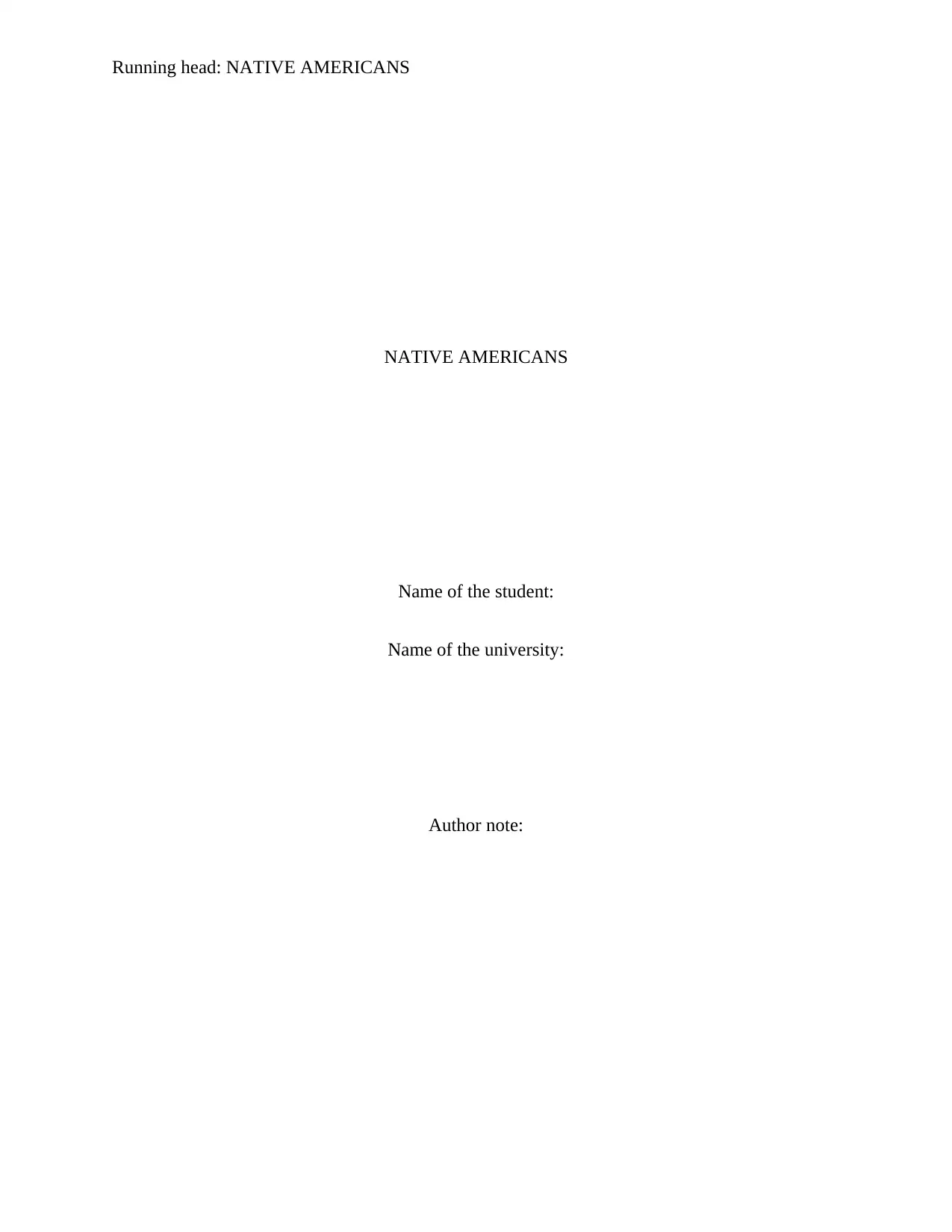
Running head: NATIVE AMERICANS
NATIVE AMERICANS
Name of the student:
Name of the university:
Author note:
NATIVE AMERICANS
Name of the student:
Name of the university:
Author note:
Paraphrase This Document
Need a fresh take? Get an instant paraphrase of this document with our AI Paraphraser
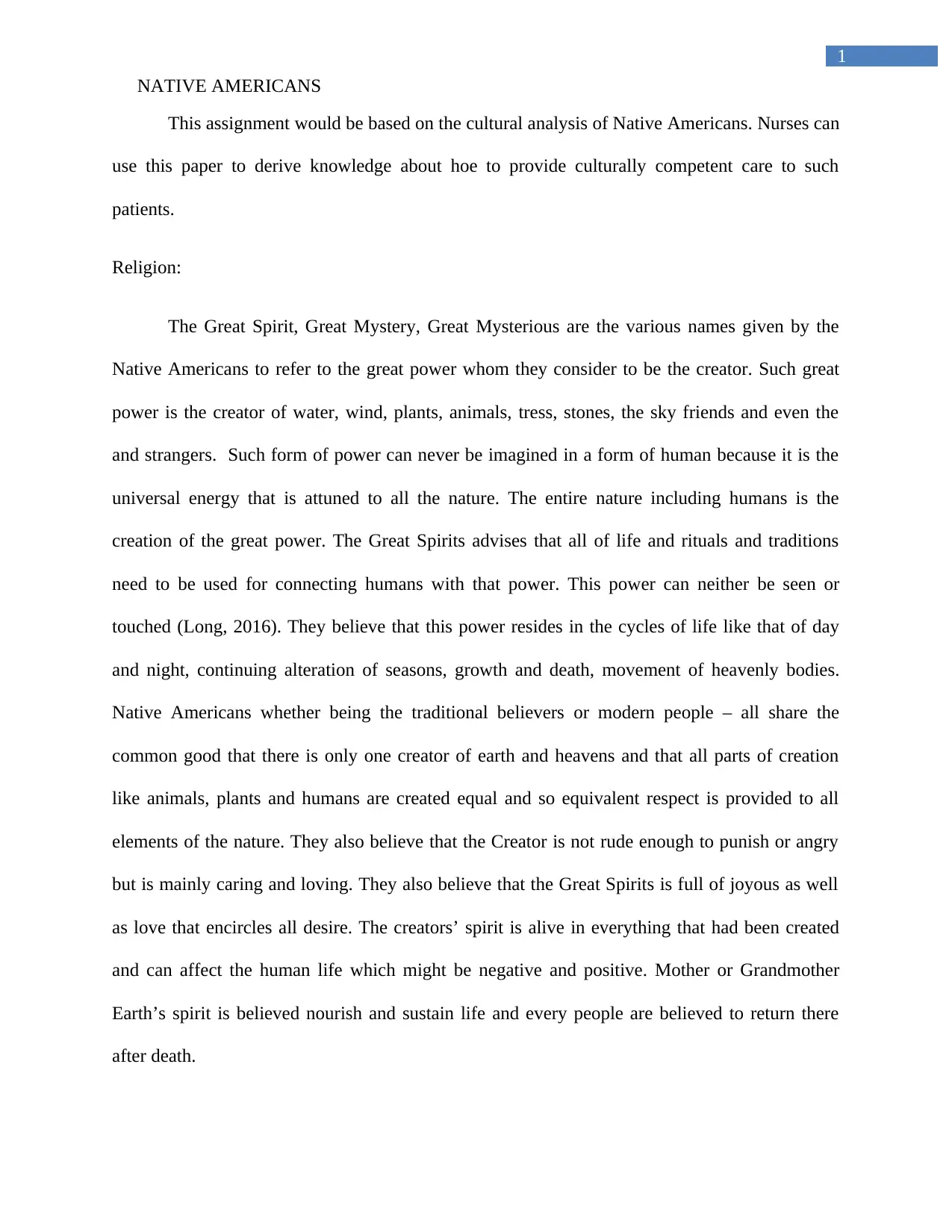
1
NATIVE AMERICANS
This assignment would be based on the cultural analysis of Native Americans. Nurses can
use this paper to derive knowledge about hoe to provide culturally competent care to such
patients.
Religion:
The Great Spirit, Great Mystery, Great Mysterious are the various names given by the
Native Americans to refer to the great power whom they consider to be the creator. Such great
power is the creator of water, wind, plants, animals, tress, stones, the sky friends and even the
and strangers. Such form of power can never be imagined in a form of human because it is the
universal energy that is attuned to all the nature. The entire nature including humans is the
creation of the great power. The Great Spirits advises that all of life and rituals and traditions
need to be used for connecting humans with that power. This power can neither be seen or
touched (Long, 2016). They believe that this power resides in the cycles of life like that of day
and night, continuing alteration of seasons, growth and death, movement of heavenly bodies.
Native Americans whether being the traditional believers or modern people – all share the
common good that there is only one creator of earth and heavens and that all parts of creation
like animals, plants and humans are created equal and so equivalent respect is provided to all
elements of the nature. They also believe that the Creator is not rude enough to punish or angry
but is mainly caring and loving. They also believe that the Great Spirits is full of joyous as well
as love that encircles all desire. The creators’ spirit is alive in everything that had been created
and can affect the human life which might be negative and positive. Mother or Grandmother
Earth’s spirit is believed nourish and sustain life and every people are believed to return there
after death.
NATIVE AMERICANS
This assignment would be based on the cultural analysis of Native Americans. Nurses can
use this paper to derive knowledge about hoe to provide culturally competent care to such
patients.
Religion:
The Great Spirit, Great Mystery, Great Mysterious are the various names given by the
Native Americans to refer to the great power whom they consider to be the creator. Such great
power is the creator of water, wind, plants, animals, tress, stones, the sky friends and even the
and strangers. Such form of power can never be imagined in a form of human because it is the
universal energy that is attuned to all the nature. The entire nature including humans is the
creation of the great power. The Great Spirits advises that all of life and rituals and traditions
need to be used for connecting humans with that power. This power can neither be seen or
touched (Long, 2016). They believe that this power resides in the cycles of life like that of day
and night, continuing alteration of seasons, growth and death, movement of heavenly bodies.
Native Americans whether being the traditional believers or modern people – all share the
common good that there is only one creator of earth and heavens and that all parts of creation
like animals, plants and humans are created equal and so equivalent respect is provided to all
elements of the nature. They also believe that the Creator is not rude enough to punish or angry
but is mainly caring and loving. They also believe that the Great Spirits is full of joyous as well
as love that encircles all desire. The creators’ spirit is alive in everything that had been created
and can affect the human life which might be negative and positive. Mother or Grandmother
Earth’s spirit is believed nourish and sustain life and every people are believed to return there
after death.
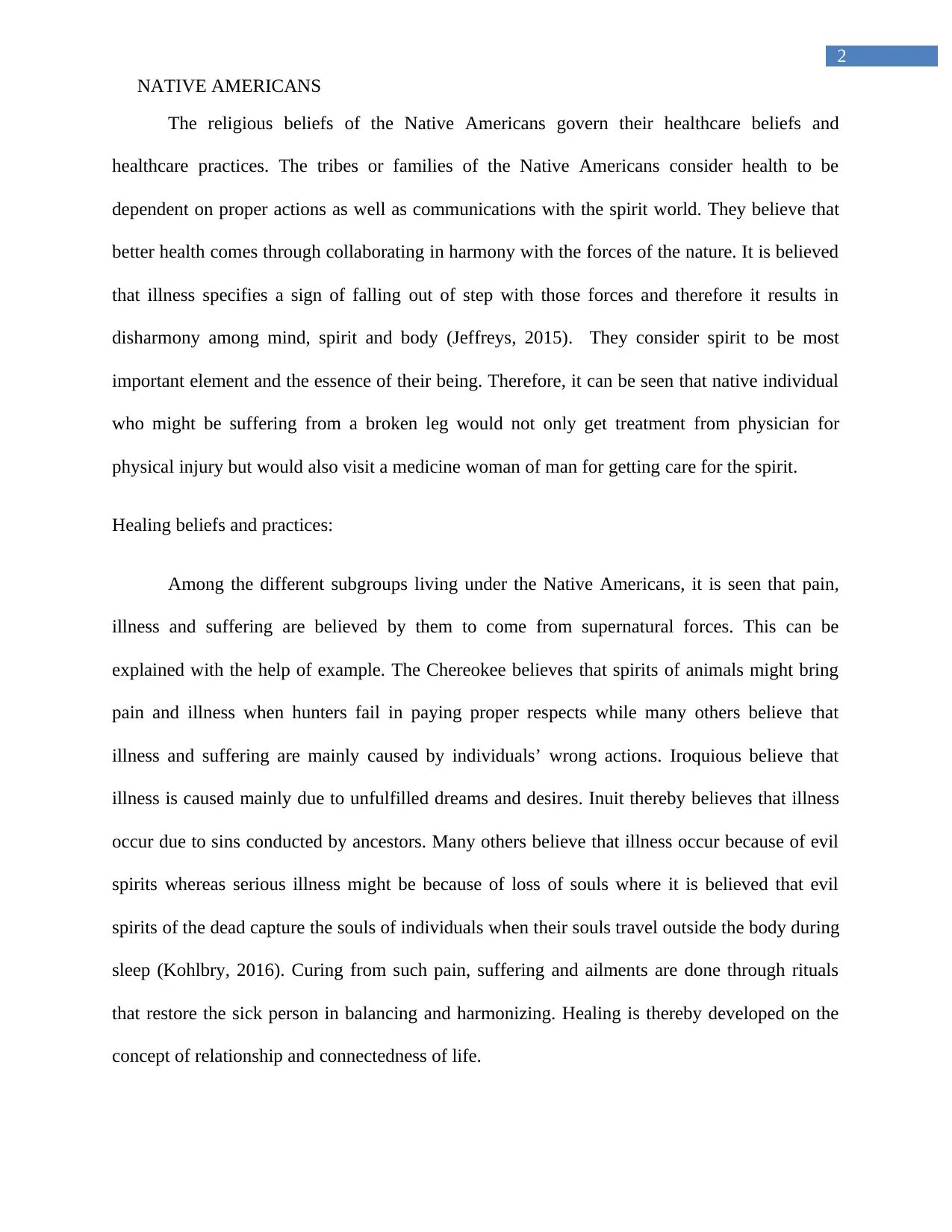
2
NATIVE AMERICANS
The religious beliefs of the Native Americans govern their healthcare beliefs and
healthcare practices. The tribes or families of the Native Americans consider health to be
dependent on proper actions as well as communications with the spirit world. They believe that
better health comes through collaborating in harmony with the forces of the nature. It is believed
that illness specifies a sign of falling out of step with those forces and therefore it results in
disharmony among mind, spirit and body (Jeffreys, 2015). They consider spirit to be most
important element and the essence of their being. Therefore, it can be seen that native individual
who might be suffering from a broken leg would not only get treatment from physician for
physical injury but would also visit a medicine woman of man for getting care for the spirit.
Healing beliefs and practices:
Among the different subgroups living under the Native Americans, it is seen that pain,
illness and suffering are believed by them to come from supernatural forces. This can be
explained with the help of example. The Chereokee believes that spirits of animals might bring
pain and illness when hunters fail in paying proper respects while many others believe that
illness and suffering are mainly caused by individuals’ wrong actions. Iroquious believe that
illness is caused mainly due to unfulfilled dreams and desires. Inuit thereby believes that illness
occur due to sins conducted by ancestors. Many others believe that illness occur because of evil
spirits whereas serious illness might be because of loss of souls where it is believed that evil
spirits of the dead capture the souls of individuals when their souls travel outside the body during
sleep (Kohlbry, 2016). Curing from such pain, suffering and ailments are done through rituals
that restore the sick person in balancing and harmonizing. Healing is thereby developed on the
concept of relationship and connectedness of life.
NATIVE AMERICANS
The religious beliefs of the Native Americans govern their healthcare beliefs and
healthcare practices. The tribes or families of the Native Americans consider health to be
dependent on proper actions as well as communications with the spirit world. They believe that
better health comes through collaborating in harmony with the forces of the nature. It is believed
that illness specifies a sign of falling out of step with those forces and therefore it results in
disharmony among mind, spirit and body (Jeffreys, 2015). They consider spirit to be most
important element and the essence of their being. Therefore, it can be seen that native individual
who might be suffering from a broken leg would not only get treatment from physician for
physical injury but would also visit a medicine woman of man for getting care for the spirit.
Healing beliefs and practices:
Among the different subgroups living under the Native Americans, it is seen that pain,
illness and suffering are believed by them to come from supernatural forces. This can be
explained with the help of example. The Chereokee believes that spirits of animals might bring
pain and illness when hunters fail in paying proper respects while many others believe that
illness and suffering are mainly caused by individuals’ wrong actions. Iroquious believe that
illness is caused mainly due to unfulfilled dreams and desires. Inuit thereby believes that illness
occur due to sins conducted by ancestors. Many others believe that illness occur because of evil
spirits whereas serious illness might be because of loss of souls where it is believed that evil
spirits of the dead capture the souls of individuals when their souls travel outside the body during
sleep (Kohlbry, 2016). Curing from such pain, suffering and ailments are done through rituals
that restore the sick person in balancing and harmonizing. Healing is thereby developed on the
concept of relationship and connectedness of life.
⊘ This is a preview!⊘
Do you want full access?
Subscribe today to unlock all pages.

Trusted by 1+ million students worldwide
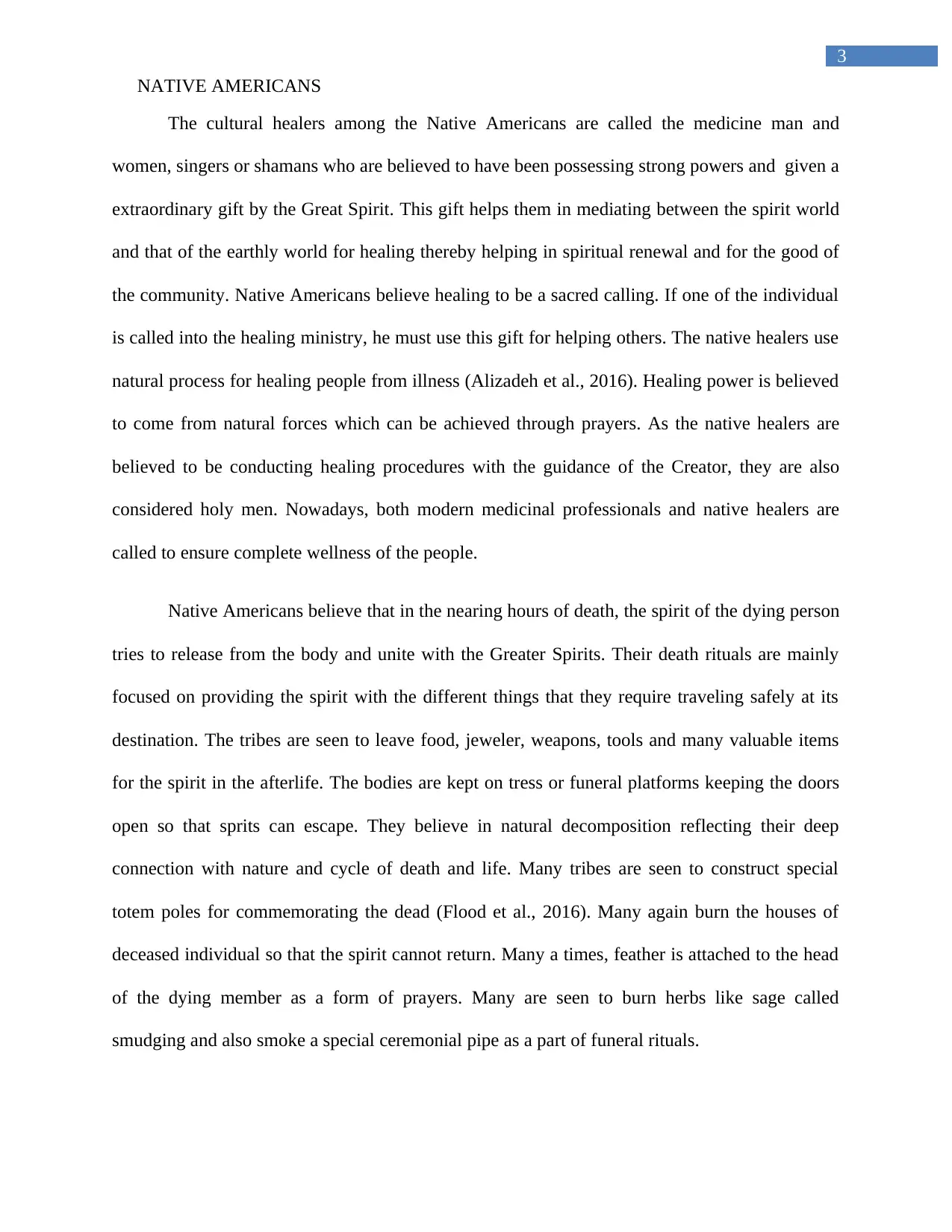
3
NATIVE AMERICANS
The cultural healers among the Native Americans are called the medicine man and
women, singers or shamans who are believed to have been possessing strong powers and given a
extraordinary gift by the Great Spirit. This gift helps them in mediating between the spirit world
and that of the earthly world for healing thereby helping in spiritual renewal and for the good of
the community. Native Americans believe healing to be a sacred calling. If one of the individual
is called into the healing ministry, he must use this gift for helping others. The native healers use
natural process for healing people from illness (Alizadeh et al., 2016). Healing power is believed
to come from natural forces which can be achieved through prayers. As the native healers are
believed to be conducting healing procedures with the guidance of the Creator, they are also
considered holy men. Nowadays, both modern medicinal professionals and native healers are
called to ensure complete wellness of the people.
Native Americans believe that in the nearing hours of death, the spirit of the dying person
tries to release from the body and unite with the Greater Spirits. Their death rituals are mainly
focused on providing the spirit with the different things that they require traveling safely at its
destination. The tribes are seen to leave food, jeweler, weapons, tools and many valuable items
for the spirit in the afterlife. The bodies are kept on tress or funeral platforms keeping the doors
open so that sprits can escape. They believe in natural decomposition reflecting their deep
connection with nature and cycle of death and life. Many tribes are seen to construct special
totem poles for commemorating the dead (Flood et al., 2016). Many again burn the houses of
deceased individual so that the spirit cannot return. Many a times, feather is attached to the head
of the dying member as a form of prayers. Many are seen to burn herbs like sage called
smudging and also smoke a special ceremonial pipe as a part of funeral rituals.
NATIVE AMERICANS
The cultural healers among the Native Americans are called the medicine man and
women, singers or shamans who are believed to have been possessing strong powers and given a
extraordinary gift by the Great Spirit. This gift helps them in mediating between the spirit world
and that of the earthly world for healing thereby helping in spiritual renewal and for the good of
the community. Native Americans believe healing to be a sacred calling. If one of the individual
is called into the healing ministry, he must use this gift for helping others. The native healers use
natural process for healing people from illness (Alizadeh et al., 2016). Healing power is believed
to come from natural forces which can be achieved through prayers. As the native healers are
believed to be conducting healing procedures with the guidance of the Creator, they are also
considered holy men. Nowadays, both modern medicinal professionals and native healers are
called to ensure complete wellness of the people.
Native Americans believe that in the nearing hours of death, the spirit of the dying person
tries to release from the body and unite with the Greater Spirits. Their death rituals are mainly
focused on providing the spirit with the different things that they require traveling safely at its
destination. The tribes are seen to leave food, jeweler, weapons, tools and many valuable items
for the spirit in the afterlife. The bodies are kept on tress or funeral platforms keeping the doors
open so that sprits can escape. They believe in natural decomposition reflecting their deep
connection with nature and cycle of death and life. Many tribes are seen to construct special
totem poles for commemorating the dead (Flood et al., 2016). Many again burn the houses of
deceased individual so that the spirit cannot return. Many a times, feather is attached to the head
of the dying member as a form of prayers. Many are seen to burn herbs like sage called
smudging and also smoke a special ceremonial pipe as a part of funeral rituals.
Paraphrase This Document
Need a fresh take? Get an instant paraphrase of this document with our AI Paraphraser
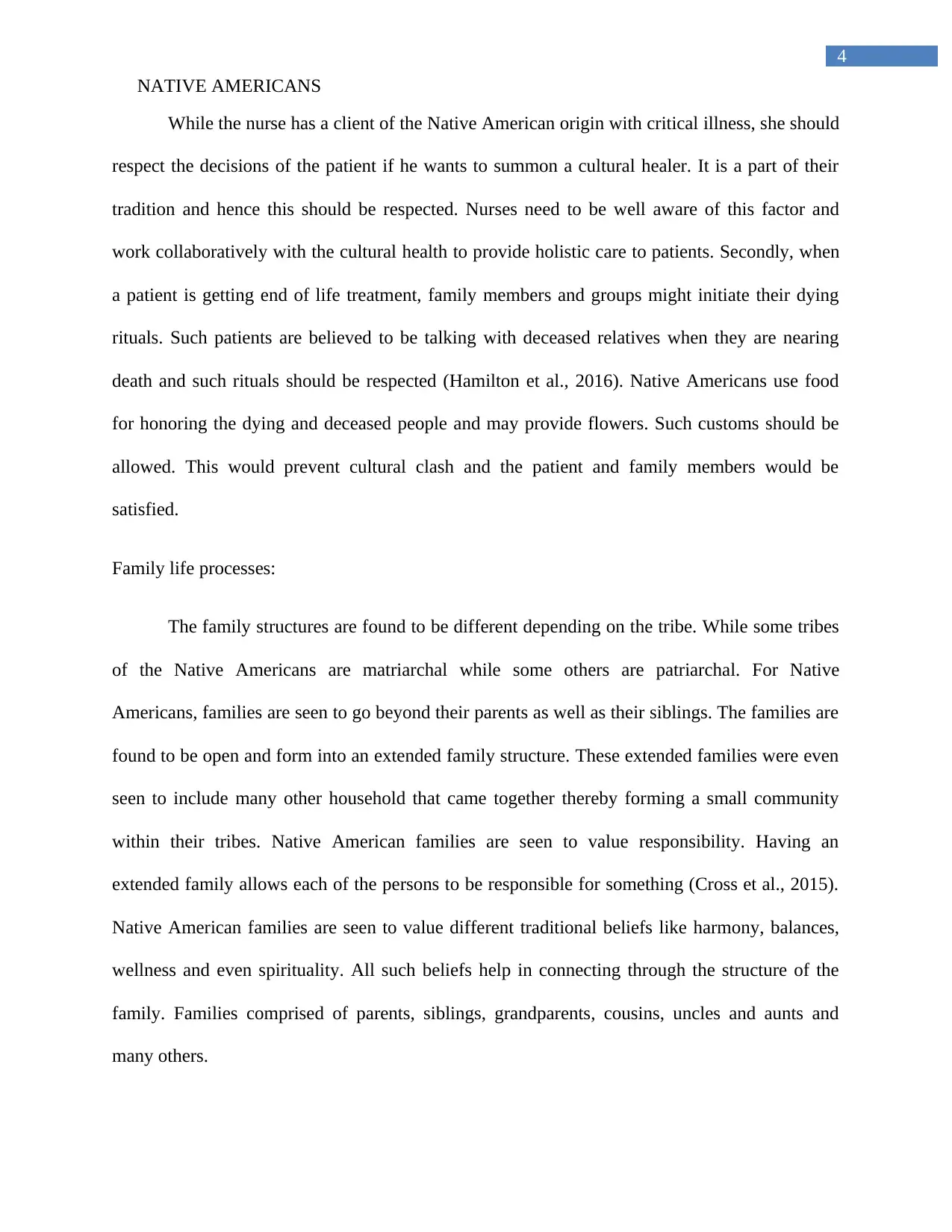
4
NATIVE AMERICANS
While the nurse has a client of the Native American origin with critical illness, she should
respect the decisions of the patient if he wants to summon a cultural healer. It is a part of their
tradition and hence this should be respected. Nurses need to be well aware of this factor and
work collaboratively with the cultural health to provide holistic care to patients. Secondly, when
a patient is getting end of life treatment, family members and groups might initiate their dying
rituals. Such patients are believed to be talking with deceased relatives when they are nearing
death and such rituals should be respected (Hamilton et al., 2016). Native Americans use food
for honoring the dying and deceased people and may provide flowers. Such customs should be
allowed. This would prevent cultural clash and the patient and family members would be
satisfied.
Family life processes:
The family structures are found to be different depending on the tribe. While some tribes
of the Native Americans are matriarchal while some others are patriarchal. For Native
Americans, families are seen to go beyond their parents as well as their siblings. The families are
found to be open and form into an extended family structure. These extended families were even
seen to include many other household that came together thereby forming a small community
within their tribes. Native American families are seen to value responsibility. Having an
extended family allows each of the persons to be responsible for something (Cross et al., 2015).
Native American families are seen to value different traditional beliefs like harmony, balances,
wellness and even spirituality. All such beliefs help in connecting through the structure of the
family. Families comprised of parents, siblings, grandparents, cousins, uncles and aunts and
many others.
NATIVE AMERICANS
While the nurse has a client of the Native American origin with critical illness, she should
respect the decisions of the patient if he wants to summon a cultural healer. It is a part of their
tradition and hence this should be respected. Nurses need to be well aware of this factor and
work collaboratively with the cultural health to provide holistic care to patients. Secondly, when
a patient is getting end of life treatment, family members and groups might initiate their dying
rituals. Such patients are believed to be talking with deceased relatives when they are nearing
death and such rituals should be respected (Hamilton et al., 2016). Native Americans use food
for honoring the dying and deceased people and may provide flowers. Such customs should be
allowed. This would prevent cultural clash and the patient and family members would be
satisfied.
Family life processes:
The family structures are found to be different depending on the tribe. While some tribes
of the Native Americans are matriarchal while some others are patriarchal. For Native
Americans, families are seen to go beyond their parents as well as their siblings. The families are
found to be open and form into an extended family structure. These extended families were even
seen to include many other household that came together thereby forming a small community
within their tribes. Native American families are seen to value responsibility. Having an
extended family allows each of the persons to be responsible for something (Cross et al., 2015).
Native American families are seen to value different traditional beliefs like harmony, balances,
wellness and even spirituality. All such beliefs help in connecting through the structure of the
family. Families comprised of parents, siblings, grandparents, cousins, uncles and aunts and
many others.

5
NATIVE AMERICANS
Elders are treated and respected with huge honor in the societies of Native Americans as
purveyors, teachers of the tribal history and lone and their advices are given huge importance.
They are seen as people with huge wisdom and knowledge and their presence is not taken for
granted or is just tolerated. Their presence is relished and enjoyed. Caring for them in the houses
is taken as important activity of the lives of the family members. Through the elders only, the
cycle of life and death are taught in the families mainly the children.
The family members of the Native Americans are closely knitted and hospitalization of
any of the member can disrupt the harmony of the family members. Such ethnic groups do not
have high health literacy and therefore they may feel quite concerned. Often when a family
member may be ill and hospitalized, the entire family may come as groups and might want to
visit the ailing person. They may not be well aware or careful about the patient to be visited by
only one single member at a time because of hospital rules. Such rules should not be pressurized
on them in such strenuous situations (Clifford et al. 2015). They might also want to bring cultural
healers with them for conducting prayers for spiritual recovery. They may also accompany
drums, and singing instruments like drums for singing prayers. Such situations should be handled
with care.
The nursing professionals would need to culturally competent in order to handle such
situations with care. Firstly, they need to be well aware of their cultural traditions, preferences
and inhibitions of the Native Americans. Following this, nurses need to allow certain customs
and traditions that remain associated with their cultist like allowing cultural healers, allowing
them to perform healing customs and similar others. At the same time, they need to undertake
specific arrangements by which the customs and traditions do not affect the patients physically.
These situations require them to use their critical reasoning skills in order to ensure that they
NATIVE AMERICANS
Elders are treated and respected with huge honor in the societies of Native Americans as
purveyors, teachers of the tribal history and lone and their advices are given huge importance.
They are seen as people with huge wisdom and knowledge and their presence is not taken for
granted or is just tolerated. Their presence is relished and enjoyed. Caring for them in the houses
is taken as important activity of the lives of the family members. Through the elders only, the
cycle of life and death are taught in the families mainly the children.
The family members of the Native Americans are closely knitted and hospitalization of
any of the member can disrupt the harmony of the family members. Such ethnic groups do not
have high health literacy and therefore they may feel quite concerned. Often when a family
member may be ill and hospitalized, the entire family may come as groups and might want to
visit the ailing person. They may not be well aware or careful about the patient to be visited by
only one single member at a time because of hospital rules. Such rules should not be pressurized
on them in such strenuous situations (Clifford et al. 2015). They might also want to bring cultural
healers with them for conducting prayers for spiritual recovery. They may also accompany
drums, and singing instruments like drums for singing prayers. Such situations should be handled
with care.
The nursing professionals would need to culturally competent in order to handle such
situations with care. Firstly, they need to be well aware of their cultural traditions, preferences
and inhibitions of the Native Americans. Following this, nurses need to allow certain customs
and traditions that remain associated with their cultist like allowing cultural healers, allowing
them to perform healing customs and similar others. At the same time, they need to undertake
specific arrangements by which the customs and traditions do not affect the patients physically.
These situations require them to use their critical reasoning skills in order to ensure that they
⊘ This is a preview!⊘
Do you want full access?
Subscribe today to unlock all pages.

Trusted by 1+ million students worldwide
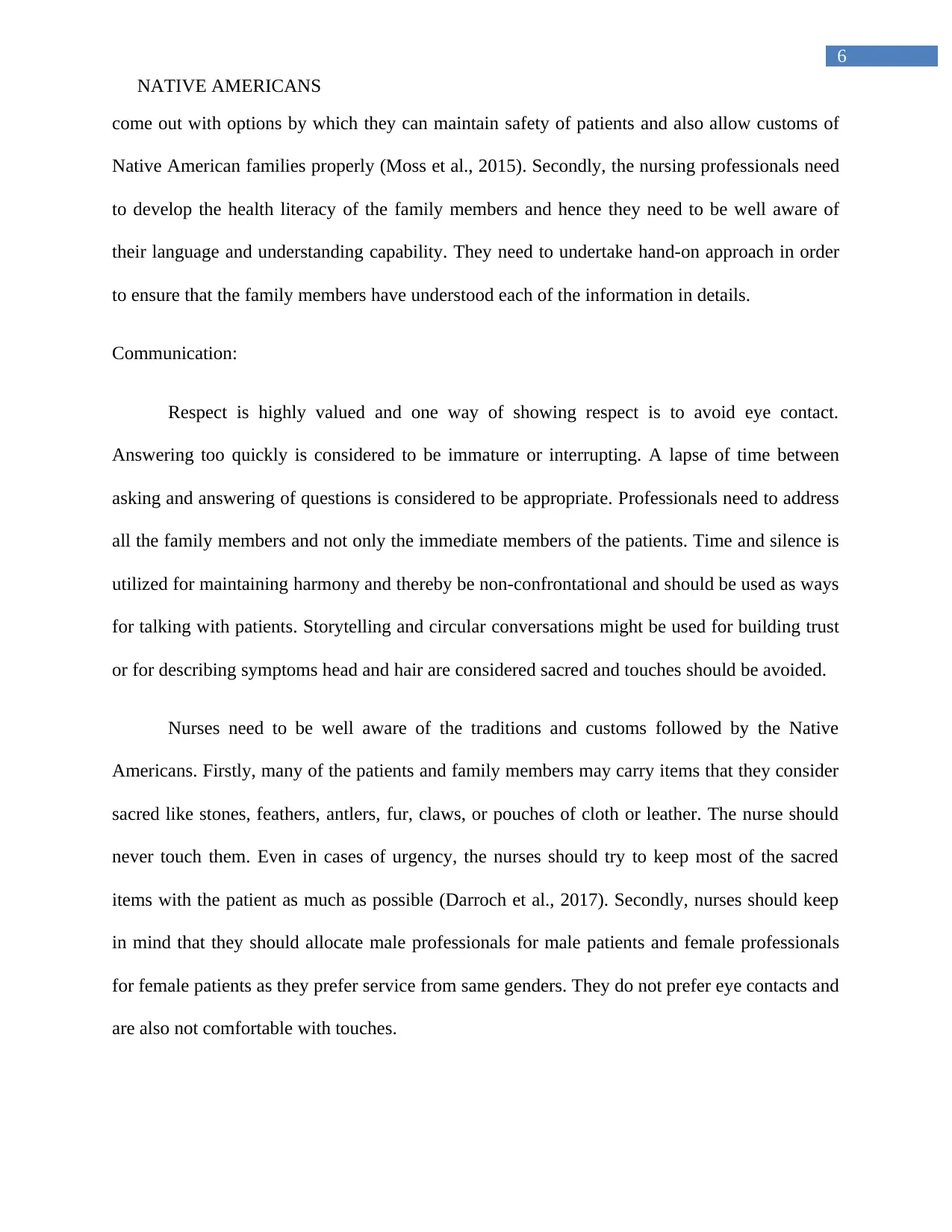
6
NATIVE AMERICANS
come out with options by which they can maintain safety of patients and also allow customs of
Native American families properly (Moss et al., 2015). Secondly, the nursing professionals need
to develop the health literacy of the family members and hence they need to be well aware of
their language and understanding capability. They need to undertake hand-on approach in order
to ensure that the family members have understood each of the information in details.
Communication:
Respect is highly valued and one way of showing respect is to avoid eye contact.
Answering too quickly is considered to be immature or interrupting. A lapse of time between
asking and answering of questions is considered to be appropriate. Professionals need to address
all the family members and not only the immediate members of the patients. Time and silence is
utilized for maintaining harmony and thereby be non-confrontational and should be used as ways
for talking with patients. Storytelling and circular conversations might be used for building trust
or for describing symptoms head and hair are considered sacred and touches should be avoided.
Nurses need to be well aware of the traditions and customs followed by the Native
Americans. Firstly, many of the patients and family members may carry items that they consider
sacred like stones, feathers, antlers, fur, claws, or pouches of cloth or leather. The nurse should
never touch them. Even in cases of urgency, the nurses should try to keep most of the sacred
items with the patient as much as possible (Darroch et al., 2017). Secondly, nurses should keep
in mind that they should allocate male professionals for male patients and female professionals
for female patients as they prefer service from same genders. They do not prefer eye contacts and
are also not comfortable with touches.
NATIVE AMERICANS
come out with options by which they can maintain safety of patients and also allow customs of
Native American families properly (Moss et al., 2015). Secondly, the nursing professionals need
to develop the health literacy of the family members and hence they need to be well aware of
their language and understanding capability. They need to undertake hand-on approach in order
to ensure that the family members have understood each of the information in details.
Communication:
Respect is highly valued and one way of showing respect is to avoid eye contact.
Answering too quickly is considered to be immature or interrupting. A lapse of time between
asking and answering of questions is considered to be appropriate. Professionals need to address
all the family members and not only the immediate members of the patients. Time and silence is
utilized for maintaining harmony and thereby be non-confrontational and should be used as ways
for talking with patients. Storytelling and circular conversations might be used for building trust
or for describing symptoms head and hair are considered sacred and touches should be avoided.
Nurses need to be well aware of the traditions and customs followed by the Native
Americans. Firstly, many of the patients and family members may carry items that they consider
sacred like stones, feathers, antlers, fur, claws, or pouches of cloth or leather. The nurse should
never touch them. Even in cases of urgency, the nurses should try to keep most of the sacred
items with the patient as much as possible (Darroch et al., 2017). Secondly, nurses should keep
in mind that they should allocate male professionals for male patients and female professionals
for female patients as they prefer service from same genders. They do not prefer eye contacts and
are also not comfortable with touches.
Paraphrase This Document
Need a fresh take? Get an instant paraphrase of this document with our AI Paraphraser
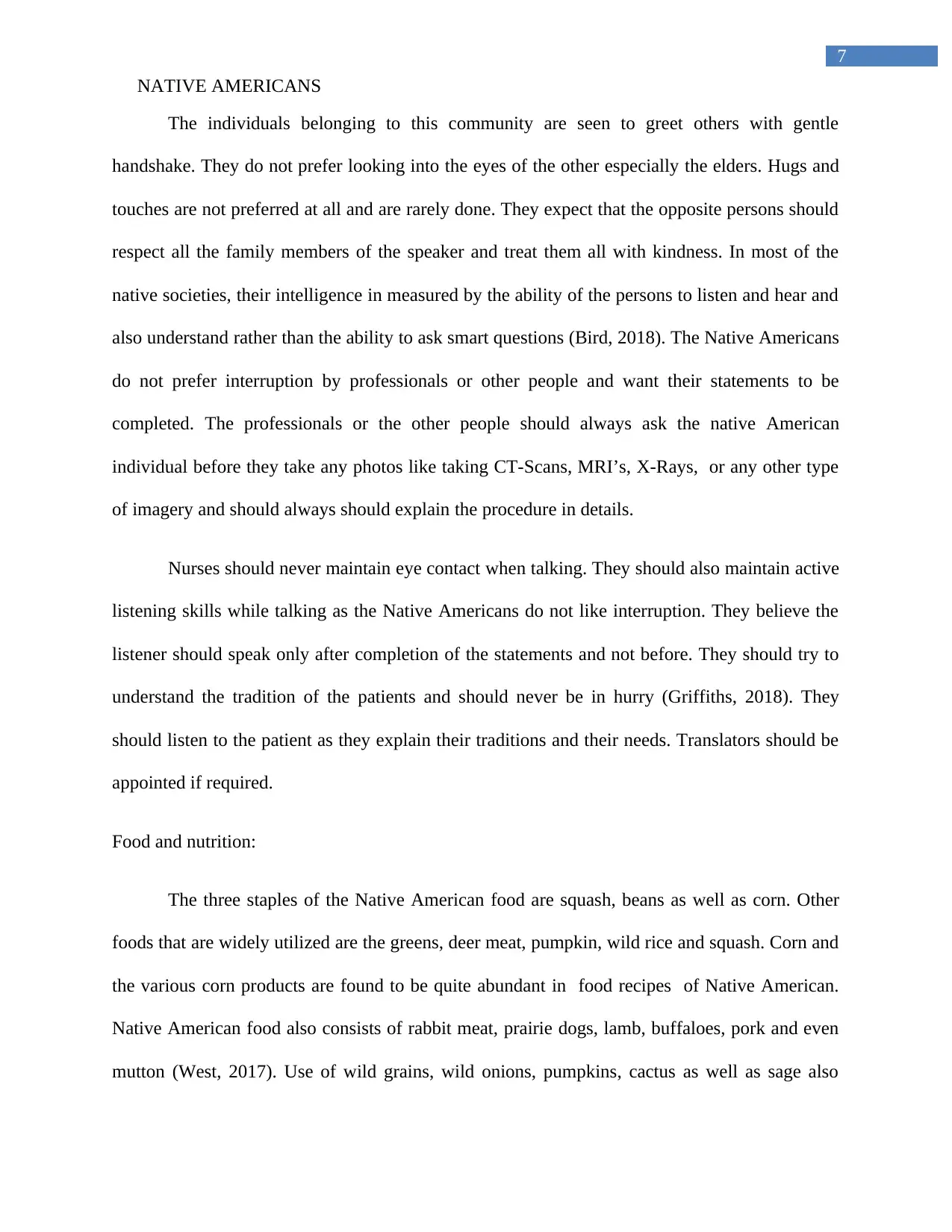
7
NATIVE AMERICANS
The individuals belonging to this community are seen to greet others with gentle
handshake. They do not prefer looking into the eyes of the other especially the elders. Hugs and
touches are not preferred at all and are rarely done. They expect that the opposite persons should
respect all the family members of the speaker and treat them all with kindness. In most of the
native societies, their intelligence in measured by the ability of the persons to listen and hear and
also understand rather than the ability to ask smart questions (Bird, 2018). The Native Americans
do not prefer interruption by professionals or other people and want their statements to be
completed. The professionals or the other people should always ask the native American
individual before they take any photos like taking CT-Scans, MRI’s, X-Rays, or any other type
of imagery and should always should explain the procedure in details.
Nurses should never maintain eye contact when talking. They should also maintain active
listening skills while talking as the Native Americans do not like interruption. They believe the
listener should speak only after completion of the statements and not before. They should try to
understand the tradition of the patients and should never be in hurry (Griffiths, 2018). They
should listen to the patient as they explain their traditions and their needs. Translators should be
appointed if required.
Food and nutrition:
The three staples of the Native American food are squash, beans as well as corn. Other
foods that are widely utilized are the greens, deer meat, pumpkin, wild rice and squash. Corn and
the various corn products are found to be quite abundant in food recipes of Native American.
Native American food also consists of rabbit meat, prairie dogs, lamb, buffaloes, pork and even
mutton (West, 2017). Use of wild grains, wild onions, pumpkins, cactus as well as sage also
NATIVE AMERICANS
The individuals belonging to this community are seen to greet others with gentle
handshake. They do not prefer looking into the eyes of the other especially the elders. Hugs and
touches are not preferred at all and are rarely done. They expect that the opposite persons should
respect all the family members of the speaker and treat them all with kindness. In most of the
native societies, their intelligence in measured by the ability of the persons to listen and hear and
also understand rather than the ability to ask smart questions (Bird, 2018). The Native Americans
do not prefer interruption by professionals or other people and want their statements to be
completed. The professionals or the other people should always ask the native American
individual before they take any photos like taking CT-Scans, MRI’s, X-Rays, or any other type
of imagery and should always should explain the procedure in details.
Nurses should never maintain eye contact when talking. They should also maintain active
listening skills while talking as the Native Americans do not like interruption. They believe the
listener should speak only after completion of the statements and not before. They should try to
understand the tradition of the patients and should never be in hurry (Griffiths, 2018). They
should listen to the patient as they explain their traditions and their needs. Translators should be
appointed if required.
Food and nutrition:
The three staples of the Native American food are squash, beans as well as corn. Other
foods that are widely utilized are the greens, deer meat, pumpkin, wild rice and squash. Corn and
the various corn products are found to be quite abundant in food recipes of Native American.
Native American food also consists of rabbit meat, prairie dogs, lamb, buffaloes, pork and even
mutton (West, 2017). Use of wild grains, wild onions, pumpkins, cactus as well as sage also

8
NATIVE AMERICANS
makes part of the diet.b traditional groups are seen to use herbs and plants such as Peppermint,
Spearmint, Clover, Sage, and Rosehips for making teas and other foods. The use of herbs and
teas during labor are also found among the groups. They are also seen to provide foods to the
deceased person in the funeral ground for their afterlives.
Fasting is considered to be a traditional part of preparation for the rite of passage
ceremonies and for spiritual discernment. It is even seen that persons who are ill are encouraged
to eat although family members fast on their behalf. Fasting is also considered to be a part of
body healing as a cleansing of toxins. Native Americans are seen to have preferences for certain
traditional foods during the ceremonial times. These are seen to be requested with special
preferences for particular teas (Tjosvold, 2017). For Native American, food has been found to
have significance beside nourishment. Live events are celebrated with food where food becomes
the center of all dances and of many religious and healing ceremonies
When special diets are prepared like diets of heart conditions and diabetics, nurses are
advised to use traditional food recipes and thereby adapt or change the recipes so that it can fit
with the dietary requirements. It has been found that elderly people of the ethnic groups are less
likely than younger individuals to change diets but they may be willing to change methods of the
preparation of foods as well as the amounts of food that are eaten. Critical care nurses therefore
needs to arrange for the elderly patients to have nutritional consultation with a dietician if
necessary (Beckstead et al., 2015).
I can use this information when I would get the opportunity to handle any Native
American patient. This paper would help me to provide culturally competent care to patients that
would align with the culture, traditions, preferences and inhibitions of this group.
NATIVE AMERICANS
makes part of the diet.b traditional groups are seen to use herbs and plants such as Peppermint,
Spearmint, Clover, Sage, and Rosehips for making teas and other foods. The use of herbs and
teas during labor are also found among the groups. They are also seen to provide foods to the
deceased person in the funeral ground for their afterlives.
Fasting is considered to be a traditional part of preparation for the rite of passage
ceremonies and for spiritual discernment. It is even seen that persons who are ill are encouraged
to eat although family members fast on their behalf. Fasting is also considered to be a part of
body healing as a cleansing of toxins. Native Americans are seen to have preferences for certain
traditional foods during the ceremonial times. These are seen to be requested with special
preferences for particular teas (Tjosvold, 2017). For Native American, food has been found to
have significance beside nourishment. Live events are celebrated with food where food becomes
the center of all dances and of many religious and healing ceremonies
When special diets are prepared like diets of heart conditions and diabetics, nurses are
advised to use traditional food recipes and thereby adapt or change the recipes so that it can fit
with the dietary requirements. It has been found that elderly people of the ethnic groups are less
likely than younger individuals to change diets but they may be willing to change methods of the
preparation of foods as well as the amounts of food that are eaten. Critical care nurses therefore
needs to arrange for the elderly patients to have nutritional consultation with a dietician if
necessary (Beckstead et al., 2015).
I can use this information when I would get the opportunity to handle any Native
American patient. This paper would help me to provide culturally competent care to patients that
would align with the culture, traditions, preferences and inhibitions of this group.
⊘ This is a preview!⊘
Do you want full access?
Subscribe today to unlock all pages.

Trusted by 1+ million students worldwide
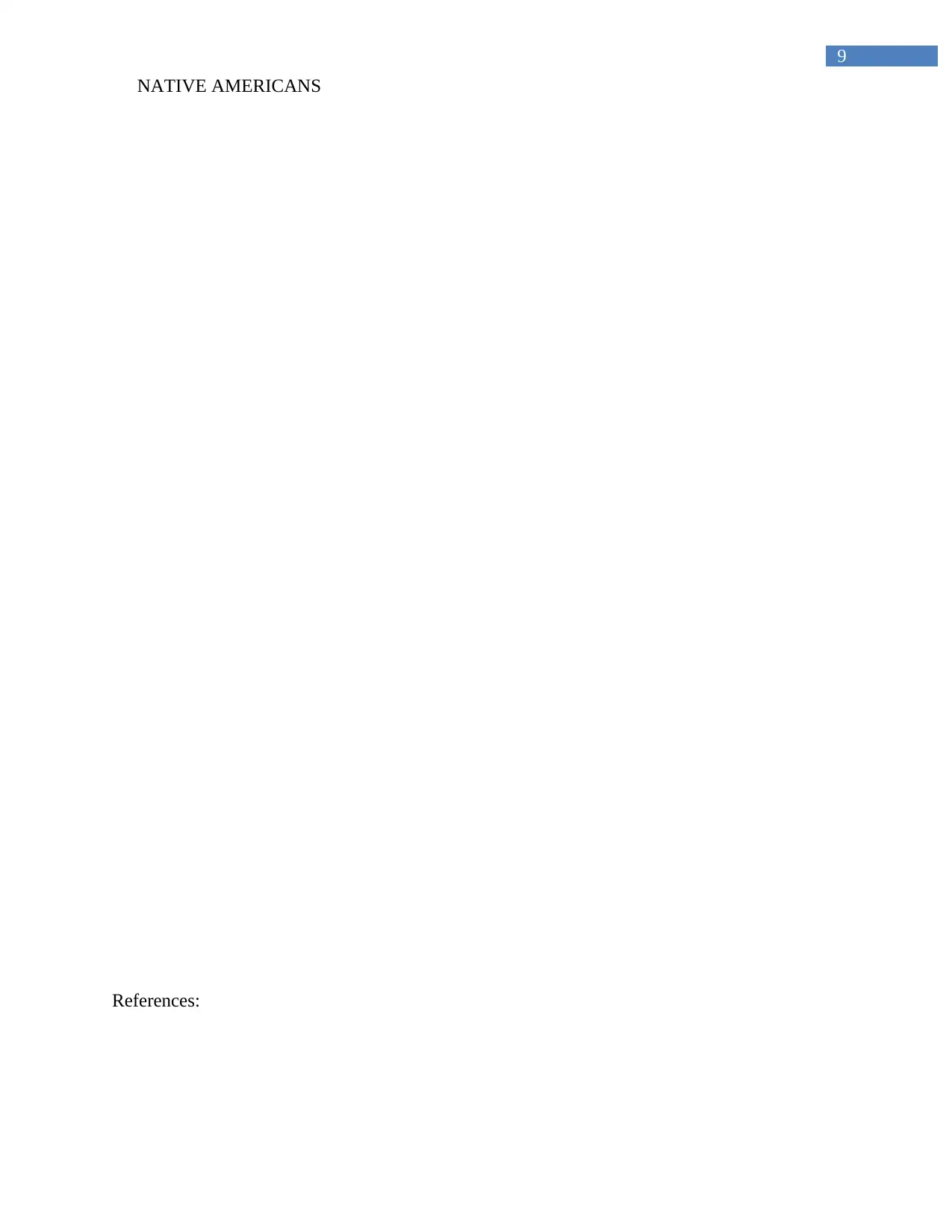
9
NATIVE AMERICANS
References:
NATIVE AMERICANS
References:
Paraphrase This Document
Need a fresh take? Get an instant paraphrase of this document with our AI Paraphraser

10
NATIVE AMERICANS
Alizadeh, S., & Chavan, M. (2016). Cultural competence dimensions and outcomes: a systematic
review of the literature. Health & social care in the community, 24(6), e117-e130.
https://doi.org/10.1111/hsc.12293
Beckstead, D. J., Lambert, M. J., DuBose, A. P., & Linehan, M. (2015). Dialectical behavior
therapy with American Indian/Alaska Native adolescents diagnosed with substance use
disorders: Combining an evidence based treatment with cultural, traditional, and spiritual
beliefs. Addictive behaviors, 51, 84-87. https://doi.org/10.1016/j.addbeh.2015.07.018
Bird, S. E. (2018). Dressing in feathers: The construction of the Indian in American popular
culture. Routledge. https://doi.org/10.4324/9780429500909
Clifford, A., McCalman, J., Bainbridge, R., & Tsey, K. (2015). Interventions to improve cultural
competency in health care for Indigenous peoples of Australia, New Zealand, Canada and the
USA: a systematic review. International Journal for Quality in Health Care, 27(2), 89-98.
https://doi.org/10.1093/intqhc/mzv010
Cross, S. L., & Day, A. G. (2015). American Indians’ response to physical pain: functional
limitations and help-seeking behaviors. Journal of social work in disability &
rehabilitation, 14(3-4), 176-191.
https://www.tandfonline.com/doi/abs/10.1080/1536710X.2015.1068257
Darroch, F., Giles, A., Sanderson, P., Brooks-Cleator, L., Schwartz, A., Joseph, D., & Nosker, R.
(2017). The United States Does CAIR About Cultural Safety: Examining Cultural Safety
Within Indigenous Health Contexts in Canada and the United States. Journal of
Transcultural Nursing, 28(3), 269-277. https://doi.org/10.1177/1043659616634170
NATIVE AMERICANS
Alizadeh, S., & Chavan, M. (2016). Cultural competence dimensions and outcomes: a systematic
review of the literature. Health & social care in the community, 24(6), e117-e130.
https://doi.org/10.1111/hsc.12293
Beckstead, D. J., Lambert, M. J., DuBose, A. P., & Linehan, M. (2015). Dialectical behavior
therapy with American Indian/Alaska Native adolescents diagnosed with substance use
disorders: Combining an evidence based treatment with cultural, traditional, and spiritual
beliefs. Addictive behaviors, 51, 84-87. https://doi.org/10.1016/j.addbeh.2015.07.018
Bird, S. E. (2018). Dressing in feathers: The construction of the Indian in American popular
culture. Routledge. https://doi.org/10.4324/9780429500909
Clifford, A., McCalman, J., Bainbridge, R., & Tsey, K. (2015). Interventions to improve cultural
competency in health care for Indigenous peoples of Australia, New Zealand, Canada and the
USA: a systematic review. International Journal for Quality in Health Care, 27(2), 89-98.
https://doi.org/10.1093/intqhc/mzv010
Cross, S. L., & Day, A. G. (2015). American Indians’ response to physical pain: functional
limitations and help-seeking behaviors. Journal of social work in disability &
rehabilitation, 14(3-4), 176-191.
https://www.tandfonline.com/doi/abs/10.1080/1536710X.2015.1068257
Darroch, F., Giles, A., Sanderson, P., Brooks-Cleator, L., Schwartz, A., Joseph, D., & Nosker, R.
(2017). The United States Does CAIR About Cultural Safety: Examining Cultural Safety
Within Indigenous Health Contexts in Canada and the United States. Journal of
Transcultural Nursing, 28(3), 269-277. https://doi.org/10.1177/1043659616634170
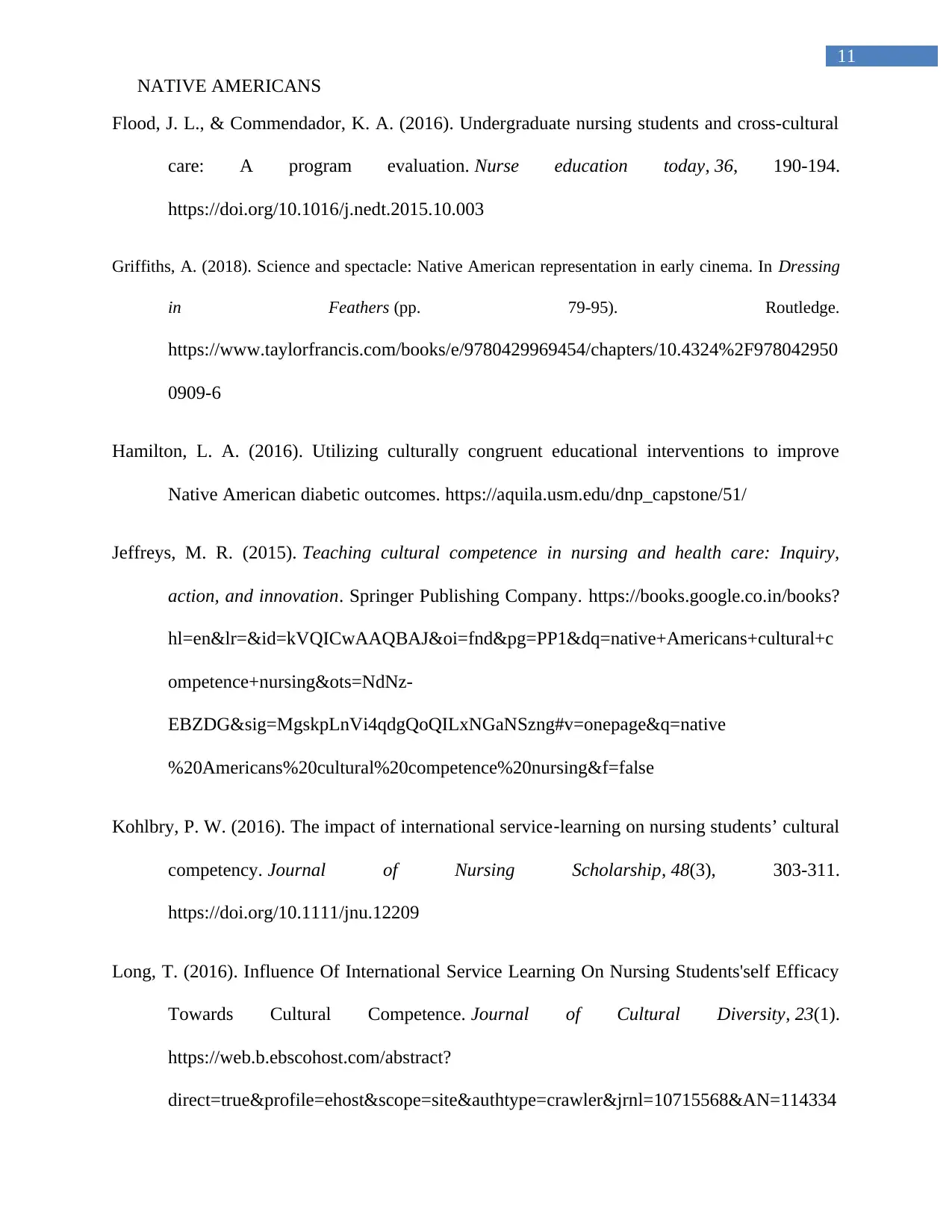
11
NATIVE AMERICANS
Flood, J. L., & Commendador, K. A. (2016). Undergraduate nursing students and cross-cultural
care: A program evaluation. Nurse education today, 36, 190-194.
https://doi.org/10.1016/j.nedt.2015.10.003
Griffiths, A. (2018). Science and spectacle: Native American representation in early cinema. In Dressing
in Feathers (pp. 79-95). Routledge.
https://www.taylorfrancis.com/books/e/9780429969454/chapters/10.4324%2F978042950
0909-6
Hamilton, L. A. (2016). Utilizing culturally congruent educational interventions to improve
Native American diabetic outcomes. https://aquila.usm.edu/dnp_capstone/51/
Jeffreys, M. R. (2015). Teaching cultural competence in nursing and health care: Inquiry,
action, and innovation. Springer Publishing Company. https://books.google.co.in/books?
hl=en&lr=&id=kVQICwAAQBAJ&oi=fnd&pg=PP1&dq=native+Americans+cultural+c
ompetence+nursing&ots=NdNz-
EBZDG&sig=MgskpLnVi4qdgQoQILxNGaNSzng#v=onepage&q=native
%20Americans%20cultural%20competence%20nursing&f=false
Kohlbry, P. W. (2016). The impact of international service‐learning on nursing students’ cultural
competency. Journal of Nursing Scholarship, 48(3), 303-311.
https://doi.org/10.1111/jnu.12209
Long, T. (2016). Influence Of International Service Learning On Nursing Students'self Efficacy
Towards Cultural Competence. Journal of Cultural Diversity, 23(1).
https://web.b.ebscohost.com/abstract?
direct=true&profile=ehost&scope=site&authtype=crawler&jrnl=10715568&AN=114334
NATIVE AMERICANS
Flood, J. L., & Commendador, K. A. (2016). Undergraduate nursing students and cross-cultural
care: A program evaluation. Nurse education today, 36, 190-194.
https://doi.org/10.1016/j.nedt.2015.10.003
Griffiths, A. (2018). Science and spectacle: Native American representation in early cinema. In Dressing
in Feathers (pp. 79-95). Routledge.
https://www.taylorfrancis.com/books/e/9780429969454/chapters/10.4324%2F978042950
0909-6
Hamilton, L. A. (2016). Utilizing culturally congruent educational interventions to improve
Native American diabetic outcomes. https://aquila.usm.edu/dnp_capstone/51/
Jeffreys, M. R. (2015). Teaching cultural competence in nursing and health care: Inquiry,
action, and innovation. Springer Publishing Company. https://books.google.co.in/books?
hl=en&lr=&id=kVQICwAAQBAJ&oi=fnd&pg=PP1&dq=native+Americans+cultural+c
ompetence+nursing&ots=NdNz-
EBZDG&sig=MgskpLnVi4qdgQoQILxNGaNSzng#v=onepage&q=native
%20Americans%20cultural%20competence%20nursing&f=false
Kohlbry, P. W. (2016). The impact of international service‐learning on nursing students’ cultural
competency. Journal of Nursing Scholarship, 48(3), 303-311.
https://doi.org/10.1111/jnu.12209
Long, T. (2016). Influence Of International Service Learning On Nursing Students'self Efficacy
Towards Cultural Competence. Journal of Cultural Diversity, 23(1).
https://web.b.ebscohost.com/abstract?
direct=true&profile=ehost&scope=site&authtype=crawler&jrnl=10715568&AN=114334
⊘ This is a preview!⊘
Do you want full access?
Subscribe today to unlock all pages.

Trusted by 1+ million students worldwide
1 out of 14
Related Documents
Your All-in-One AI-Powered Toolkit for Academic Success.
+13062052269
info@desklib.com
Available 24*7 on WhatsApp / Email
![[object Object]](/_next/static/media/star-bottom.7253800d.svg)
Unlock your academic potential
Copyright © 2020–2025 A2Z Services. All Rights Reserved. Developed and managed by ZUCOL.





